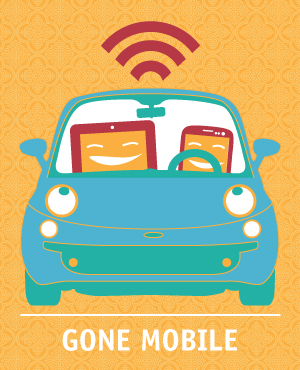You Really Need to Go Mobile Friendly, Now!
Dad always taught me that first impressions are how people will remember you. A warm honest smile and a solid handshake go a long way when you meet someone. This fatherly advice is relevant beyond face-to-face meetings. As technology continues to grow, first impressions are happening with the click of a button, hundreds of times a day. Whether you have a website for a brick-and-mortar business or you're a dedicated blogger, it's important to optimize your site for mobile use, so when web-surfers are first introduced to you they want to hang out again soon.
2 Big Reasons to Design for Mobile:
1. The Mobile Market is Growing
- 53% of US has a smart phone
- 25% of people in the US only access web on mobile
- Mobile Traffic comprises 15% of total global internet traffic
These are some big numbers, and the growth is only increasing. People are accessing the web whenever and wherever they can. However, mobile doesn't just mean on the go anymore.
Many people who can only afford one device to access the internet are choosing the phone. The only way your site will reach these folks is by having a strong site optimized for mobile use.
For others, the double screen experience is too strong of a pull for our attention craving minds: 68% of mobile web browsing is done in the home. It's very easy to shop online during commercial breaks, and think of a typical morning for many smart phone users: the alarm on your phone wakes you up and you check your emails before even getting out of bed.
Today the internet is everywhere, so using it should be a seamless and simple process no matter how you surf.
2. Design with Mobile in Mind Enhances User Experience
- Cater to the limited navigational tools and small screen of a mobile device
- Facilitate access with quicker load times and formats specific to the mobile platform
Some of you may be sitting back with a smug and satisfied grin on your face. Enhance user experience, pshaw, we have that covered. You open a new tab and take a quick look at the masterpiece of a website you've composed. It practically beams at you from the 27 inch iMac screen - it's gorgeous.
But, have you tried checking your site on your phone? Suddenly, all that amazing content is lost on the smaller screen, the pinch and zoom frustratingly limits your ability to use the site, and you have flashbacks to Netscape Navigator because it takes so long to load.
Intent, Intent, Intent
There are a couple of options for optimizing your current website to fit a mobile interface. Which route you should choose very much depends on your particular context.
There are two different approaches your site can take when optimizing for the mobile platform, a separate mobile site or responsive design. The choice greatly depends on the intentions of your site. Are you a blogger feeding content to the world, or are you a business peddling your wares across the cyber silk-road?
Web businesses or retailers with brick and mortar locations will benefit from a separate mobile site. The advantages of this strategy are that it delivers what the customers want quickly and highlights the key features of the full website.
Quick load times and simple navigation are great perks, but the down side is that some features of the full site are lost in a dedicated mobile site. This takes away the full experience from users on a mobile device. This is an avoidable problem for certain businesses, like a delivery company, where the website is just about getting the customers what they want and quickly.
Some suggested user interface ideas:
- very prominent store locator button
- simple click to call interface
Another mobile approach that is better suited for content based sites is responsive design. This is because the intent of a content based audience is to consume information.
A casual and eclectic approach to browsing is all about easy navigation in order to avoid boredom and get information, therefore limiting the features of a site is very inadvisable. Responsive design truly allows free range, surfing discoveries across any device.
There are downsides to responsive design as well, namely performance. When a responsive site is not properly designed, the hidden code can make the site heavy, and this is detrimental because mobile users simply lack patience.
Like most things, both strategies have benefits as well as drawbacks. The most important thing is to find out what will work best for you.
Don't let your website fall into the sullen world of online wall flowers by ensuring that your first impression to customers is a strong one. Understand how your users visit your site and deliver an effective strategy based on both of your needs. Optimizing for mobile is crucial to making sure your site is remembered, visited, and loved.
Have a Pawsitively Tail Waggin' Good Day!
P.S. This information was provided by Ruff Haus - Your Loyal Marketing Companion. Established in 1997, we are a special breed of brand design company that works with a premier pack of clients. We bring a fresh outlook and tail-wagging enthusiasm to your marketing program.


